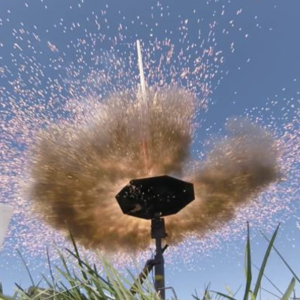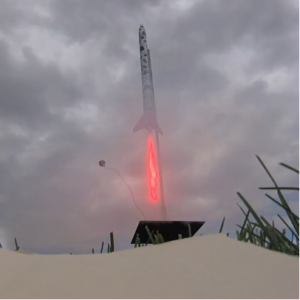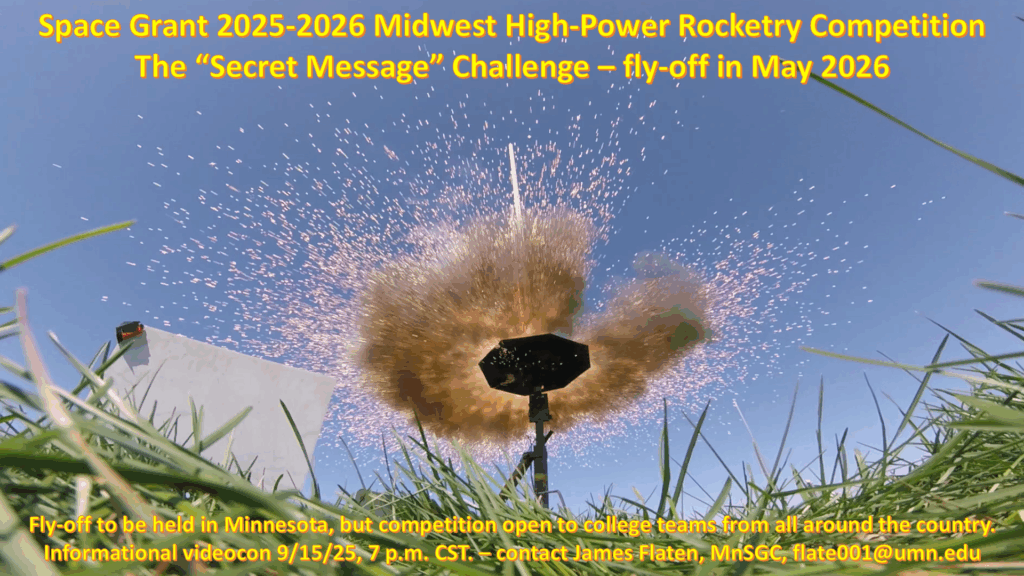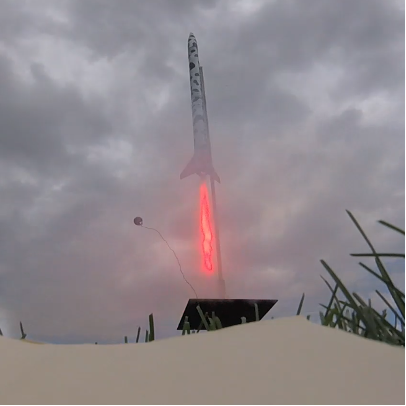Unique NASA Opportunity to
Design, Build, and Launch High-Power Rockets
 The Minnesota Space Grant Consortium, working with the Tripoli MN High Power Rocketry Club, hereby announces the 2025-2026 Space Grant Midwest High-Power Rocketry Competition.
The Minnesota Space Grant Consortium, working with the Tripoli MN High Power Rocketry Club, hereby announces the 2025-2026 Space Grant Midwest High-Power Rocketry Competition.
The fly-off will be held in Minnesota, but this competition is open to college and university student teams from across the nation during the 2025-2026 academic year. This competition is an opportunity for students to design and construct high-power rockets, to be launched in May 2026 from a Tripoli high-power rocket club launch site just north of Minneapolis.
No previous experience in high-power rocketry is necessary to compete!
Up to 30 college and university teams, sponsored by their states’ Space Grant organizations, will be accepted into this competition.

Local Space Grant Support
Interested teams from any state, not just those in the Space Grant Great (Lakes) Midwest Region, are required to garner local Space Grant “sponsorship” (this might or might not involve financial support, depending on the state) and submit a non-binding “Notice of Intent to Compete” to the Minnesota Space Grant Consortium by September 30, 2025, in which they list the team’s student members and students’ certification level (if any), team name, and a committed faculty adviser.
Note — institutions not planning to start until Spring 2026 should still submit a Notice of Intent to Compete to the Minnesota Space Grant Consortium by September 30, 2025, naming a faculty adviser (so that we know who to send updates to).
Teams are also required to consult with a non-student mentor who has high-power rocketry experience and is Level 2 certified (or higher). Competition organizers can help teams find certified high-power rocketry mentors, if need be.
A kickoff informational videocon about the Space Grant Midwest Competition for teams planning to spend the full academic year on this project will be held from 7–8 p.m. CDT on Monday, September 15 2025. This kick-off informational videocon will be repeated on Thursday, January 8, 2026, for teams working just during the winter and spring terms.
A registration fee of $400 per team, due by December 1, 2025, will be charged to cover competition costs, of which approximately $100 will be applied toward the purchase of two motors for use at the in-person competition fly-off.
Note — Motor(s) for test flights need to be ordered along with the Notice of Intent to Compete and paid for with registration. States sponsoring two or three teams will be expected to provide one judge for written and oral reports and the (in-person) competition fly-off. States fielding four or more teams may be asked to provide two judges.
Contact James Flaten at flate001@umn.edu for call-in details.
2025-2026 Space Grant
Midwest High-Power
“Secret Message” Challenge
Summary Description
Student teams will design and construct single-motor, single-stage, high-power rocket to fly twice during the competition.
This year the challenges are:
• Have the rocket carry a down-facing camera system to collect in-flight video watching a set of up-facing bright lights spread out near the launch pads that are flashing a repeating coded message (about 10 seconds long, with new patterns displayed approximately every half second) and keep the set of lights in view and be able to distinguish the patterns for as long as possible, during both ascent and descent.
• Implement a roll-control mechanism, with indicator lights in view of the down-facing camera system, showing what the mechanism is trying to do. Demonstrate the ability to control the roll of the rocket on ascent (at least roll clockwise 90°, then roll counter-clockwise 90°). Note: Teams can try to use the roll control capability to keep the set of lights in view.
• Have the rocket carry a “non-commercial” (i.e., not sold for rocketry) data-logging sensor suite and use it to log at least once a second (even faster would be better) GPS (latitude, longitude, and altitude), ambient pressure, 3-axis acceleration, 3-axis roll, and status of the roll control mechanism during the entire flight.
• One competition flight will use a 29-millimeter diameter AeroTech H195 DMS single-use motor (no case required). The second flight will use a 38-millimeter diameter Cesaroni I170 (requires a 3-grain case) reloadable motor.
Bonus points will be given to:
(1) Teams whose member(s) increase their certification level(s) using individually-built rockets (in parallel with the (team-built) competition rocket),
(2) Teams that implement a telemetry system with which they can transmit information about the pattern of lights (i.e., evidence that they “got the message,” even if they cannot decode it (yet)) to a ground station located near the LCO table within 10 minutes of landing and before going out to recover the rocket, and
(3) Teams that are able to decode the message (more bonus points given to teams that decode the message more quickly).
Additional details about the competition will be included in a handbook, including due dates and report content and page limits. Note: All fabrication work on the rocket(s), except for possibly machining of plastic and/or metal parts, must be performed by students.
•
The competition will include two written reports about the design, analysis, simulation, build, and test flight results of the competition rocket, an oral presentation, plus a written assessment of competition flight data and results.
These will be scored by a panel of professional engineers from both academia and industry. Scoring of the pre-fly-off reports and the post-flight reports will focus on rocket design and performance.
More details about the competition motors, reports, and deadlines will be described in the competition handbook and discussed during the informational videocons.
A competition handbook, including a more-extensive description of the challenge rules, will be posted at this link by September 15, 2025.
Logistical questions may be directed to James Flaten, Minnesota Space Grant and University of Minnesota Twin Cities, flate001@umn.edu.
Technical questions may be directed to Gary Stroick, Tripoli MN High-Power Rocketry Club, president@offwegorocketry.com.
Important Dates
- Kick-off informational videocon: Monday, Sept. 15, 2025, from 7–8 p.m. CDT (repeated Thursday, January 8, 2026 from 7–8 p.m. CST). Contact James Flaten at flate001@umn.edu for call-in information)
- Submit a (non-binding) “Notice of Intent to Compete” and test-flight motor order by September 30, 2025. (This deadline applies to all teams, even to teams not forming until later in the school year.)
- A non-refundable $400 Team Registration Fee is due by December 1, 2025, about $100 of which will purchase the team’s two competition motors.
- In-person Competition Dates:
Presentations & Safety Checks on Saturday, May 16, 2026* (mid-afternoon & evening);
Flights on Sunday, May 17, 2026* (all day, plus an evening banquet (even if we have not flown)). - Alternate (weather-delay) Flight Date: Monday, May 18, 2026*(as long as needed).
*If Minnesota has a particularly wet spring and the launch site clearly will not be usable by mid-May, the competition dates might need to shift. This will be announced as far in advance as is practical. See details in the handbook.
•

